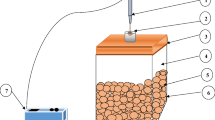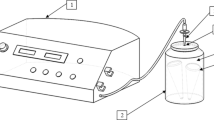Abstract
Anaerobic respiration is a major problem that causes the deterioration of fresh produce packaged under low O2 atmospheres. The problem becomes more severe and causes high losses in the packages handling at ambient conditions, especially in developing countries. In designing modified atmosphere packaging, the risk of anaerobic development greatly depends upon the accuracy of respiration rate prediction; therefore, the respiration rate model for a particular produce has to be identified. In this study, different atmospheric storage conditions in a closed system were realized to examine the adaptability of respiration rate models for spinach storage under low O2 at an expected ambient temperature of 25 °C. Six models were applied and it was found that, for aerobic conditions, the respiration rate could be described with a constant respiratory quotient by three models, viz., (a) Michaelis–Menten model without inhibition, (b) Michaelis–Menten model with uncompetitive inhibition, and (c) Langmuir adsorption model, whereas three other models, viz. (d) Michaelis–Menten model with competitive inhibition, (e) Michaelis–Menten model with noncompetitive inhibition, and (f) Michaelis–Menten with mixed inhibition could not be fitted. Among the three successful models, the Michaelis–Menten with uncompetitive inhibition was found to be the most suitable model for practical applications in developing countries where cold-chain systems are lacking. This model can be applied for the prediction of gas composition and optimize the packages, particularly to ensure the aerobic respiration.








Similar content being viewed by others
References
Abdel-Nour, N., Ngadi, M., Prasher, S., & Karimi, Y. (2009). Prediction of egg freshness and albumin quality using visible/near infrared spectroscopy. Food and Bioprocess Technology. doi:10.1007/s11947-009-0265-0.
Akimoto, K., Maezawa, S., & Kato, Y. (1996). Effect of dynamic accumulation of carbon dioxide on respiration rate and freshness of spinach. Research Bulletin of Faculty of Agriculture, Gifu University, 61, 75–80 (in Japanese).
Allende, A., Luo, Y., McEvoy, J. L., Artes, F., & Wang, C. Y. (2004). Microbial and quality changes in minimally processed baby spinach leaves stored under super atmospheric oxygen and modified atmosphere conditions. Postharvest Biology and Technology, 33, 51–59.
Andrich, G., Fiorentini, R., Tuci, A., Zinnai, A., & Sommovigo, G. (1991). A tentative model to describe respiration of stored apples. Journal of American Society for Horticulture Science, 116, 478–481.
Banks, N. H., Dadzie, B. K., & Cleland, D. J. (1993). Reducing gas exchange of fruits with surface coatings. Postharvest Biology and Technology, 3(3), 269–284.
Beaudry, R. M., & Gran, C. D. (1993). Using a modified-atmosphere packaging approach to answer some postharvest questions: Factors influencing the lower O2 limit. Acta Horticulturae, 362, 203–212.
Bhande, S. D., Ravindra, M. R., & Goswami, T. K. (2008). Respiration rate of banana fruit under aerobic conditions at different storage temperatures. Journal of Food Engineering, 87(1), 116–123.
Cameron, A. C., Boylan-Pett, W., & Lee, J. (1989). Design of modified atmosphere packaging systems: Modeling oxygen concentrations within sealed packages of tomato fruits. Journal of Food Science, 54(6), 1413–1421.
Conte, A., Conversa, G., Scrocco, C., Brescia, I., Laverse, J., Elia, A., et al. (2008). Influence of growing periods on quality of baby spinach leaves at harvest and during storage as minimally processed produce. Postharvest Biology and Technology, 50(2–3), 190–196.
Dadzie, B. K., Banks, N. H., Cleland, D. J., & Hewitt, E. W. (1996). Changes in respiration and ethylene production of apples in response to internal and external oxygen partial pressures. Postharvest Biology and Technology, 9(3), 297–309.
Emond, J. P., Chau, K. V., & Brecht, J. K. (1993). Modeling respiration rates of blueberry in a perforation-generated modified atmosphere package. In: Proceedings of the 6th international controlled atmosphere research conference (pp. 134–144). Ithaca, New York, USA.
FAO. (2009). Post-harvest losses aggravate hunger; improved technology and training show success in reducing losses. Rome: Food and Agriculture Organization of the United Nations. Available at: www.fao.org. Accessed 26 Mar 2010.
Fishman, S., Rodov, V., & Ben-Yehoshua, S. (1996). Mathematical model for perforation effect on oxygen and water vapor dynamics in modified atmosphere packages. Journal of Food Science, 61(5), 956–961.
Fonseca, S. C., Oliveira, F. A. R., & Brecheht, J. K. (2002). Modelling respiration rate of fruits and vegetables for modified atmosphere packages: A review. Journal of Food Engineering, 52(2), 99–119.
Gran, C. D., & Beaudry, R. M. (1993). Determination of low O2 limit for several commercial apple cultivars by respiratory quotient breakpoint. Postharvest Biology and Technology, 3(3), 259–267.
Hertog, M. L. A. T. M. (2001) Improving modified atmosphere packaging through conceptual models. In: Food process modelling. Modelling (p. 229). Cambridge: Woodhead.
Kader, A. A. & Ke, D. (1994) Controlled atmospheres. In: Treatments and responses (pp 223–226). Wallingford: CAB International.
Kader, A. A. & Saltveit, M. E. (2003) Respiration and gases exchange. In: Postharvest physiology and pathology of vegetables (p. 11). New York: Marcel Dekker.
Ko, N. P., Watada, A. E., Schlimme, D. V., & Bouwkamp, J. C. (1996). Storage of spinach under low oxygen atmosphere above the extinction point. Journal of Food Science, 61(2), 398–401.
Lakakul, R., Beaudry, R. M., & Hernandez, R. J. (1999). Modeling respiration of apple slices in modified atmosphere packages. Journal of Food Science, 64(1), 105–110.
Lee, D. S., Haggar, P. E., Lee, J., & Yam, K. L. (1991). Model for fresh produce respiration in modified atmospheres based on principles of enzyme kinetics. Journal of Food Science, 56(6), 1580–1585.
Lencki, R. W., Zhu, M., & Chu, C. (2004). Comparison of unsteady- and steady-state methods for produce respiration rate determination 1: Model development and validation. Postharvest Biology and Technology, 31(3), 229–238.
Makino, Y., Iwasaki, K., & Hirata, T. (1996). A theoretical model for oxygen consumption in fresh produce under an atmosphere with carbon dioxide. Journal of Agricultural Engineering Research, 65(3), 193–203.
Neethirajan, S., Jayas, D. S., & Sadistap, S. (2009). Carbon dioxide (CO2) sensors for the agri-food industry—a review. Food and Bioprocess Technology, 2, 115–121.
Nunes, M. C. D. N. & Emond, J. P. (2003) Storage temperature. In: Postharvest physiology and pathology of vegetables (pp. 209–228). New York: Marcel Dekker.
O’ Hare, T. J., Wong, L. S., Prasad, A., Able, A. J., & King, G. J. (2000). Atmosphere modification extends the postharvest shelf life of fresh-cut leafy Asian brassicas. Acta Horticulturae, 539, 104–107.
Pandrangi, S., & LaBorde, L. F. (2004). Retention of folate, carotenoids, and other quality characteristics in commercially packaged fresh spinach. Journal of Food Science, 69(9), 702–707.
Peppelenbos, H. W., & Leven, J. V. (1996). Evaluation of four types of inhibition for modeling the influence of carbon dioxide on oxygen consumption of fruits and vegetables. Postharvest Biology and Technology, 7(1), 27–40.
Peppolenbos, H. W., & Oosterhaven, J. (1996). A theoretical approach on the role of fermentation in harvested plant products. Acta Horticulturae, 464, 381–386.
Ravindra, M. R., & Goswami, T. K. (2008). Modelling the respiration rate of green mature mango under aerobic conditions. Biosystem Engineering, 99(2), 239–248.
Talasila, P. C., Chau, K. V., & Brecht, J. K. (1992). Effects of gas concentrations and temperature on O2 consumption of strawberries. Transactions of the American Society of Agricultural Engineers, 35(1), 221–224.
Uchino, T., Nei, D., Hu, W., & Sorour, H. (2004). Development of mathematical model for dependence of respiration rate of fresh produce on temperature and time. Postharvest Biology and Technology, 34(3), 285–293.
Yang, C. C., & Chinnan, M. S. (1988). Modeling the effect of O2 and CO2 on respiration and quality of stored tomatoes. Transactions of the American Society of Agricultural Engineers, 31(2), 920–925.
Author information
Authors and Affiliations
Corresponding author
Rights and permissions
About this article
Cite this article
Saenmuang, S., Al-Haq, M.I., Samarakoon, H.C. et al. Evaluation of Models for Spinach Respiratory Metabolism Under Low Oxygen Atmospheres. Food Bioprocess Technol 5, 1950–1962 (2012). https://doi.org/10.1007/s11947-010-0503-5
Received:
Accepted:
Published:
Issue Date:
DOI: https://doi.org/10.1007/s11947-010-0503-5




